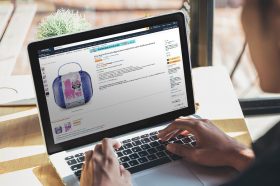Resources - Blog
How to Sell Private Label Food and Beverages on Amazon

Stay on top of the latest e-commerce and marketplace trends.
Amazon has its eyes set on the U.S. grocery industry — and for good reason. While the $700 billion category has been historically slow to shift to online, that consumer mindset is changing, presenting substantial opportunity for early players in the space.
In fact, U.S. grocery e-commerce is the fastest-growing product category online. In 2019, U.S. food and beverage e-commerce sales will grow over 18% to nearly $20 billion, according to eMarketer, with projections to reach over $38 billion by 2021. Furthermore, grocery is the fastest-growing category on Amazon, posting sales growth of over 40% in 2018, per eMarketer. Feedvisor’s ProductSphere pricing technology continually analyzes your dynamic competitive landscape to pinpoint the optimal price for your private label or branded products in real time.
What is driving this growth? As a seller or brand on Amazon, what can you do to tap into this segment and leverage its growth for the long-term success of your own business? For many, private label may be the solution.
According to a recent report from Coresight Research, annual sales of private label consumer packaged goods (CPG) are growing faster year over year than national brands. Plus, these products have a high degree of shopper loyalty, with 85% of shoppers saying they trust private brands as much as national brands.
As consumer sentiment toward both online food and beverage purchases as well as private label products continues to improve, e-commerce channels are well-suited for a rise in private label CPGs.
For Amazon sellers, private labeling offers more flexibility and control around pricing and helps reduce levels of competition on the marketplace, given that private label ASINs do not compete for the Buy Box. To launch your own private label food and beverage line on Amazon, consider the following recommendations and Amazon rules to ensure compliance and long-term success.
Technavio predicts the U.S. private label food and beverage market will grow by $20.4 billion from 2019 to 2023, driven by product premiumization.
How to Get Started Selling Private Label Food and Beverages
1. Conduct Market Research to Identify Product Gaps and Opportunities
Amazon’s marketplace is highly saturated and competition is fiercer than ever. When determining which products to add to your private label line, consider the competition levels of the broader food and beverage segment as well as niche subcategories to pinpoint any product gaps that can be filled or any areas that are over-saturated and should be avoided.
On Amazon, food and beverage sales are driven largely by CPG products like coffee, tea, snacks, and cold beverages, while sales of perishable items have yet to really take off on the platform. With that said, you may want to consider launching a product that is non-perishable and to both appeal to consumer demand as well as sustain the fulfillment process without eating into your profit margins in terms of refrigerated storage, packaging, and delivery costs.
On the other hand, if you choose to launch a food and beverage product in these pre-popular and saturated categories, it is essential that you differentiate your product and brand from your competitors. Consumers today seek better-for-you foods and brands that support sustainability, transparency, and wellness.
Once considered “cheap” and “lesser quality,” private label food and beverages in the U.S. are now flourishing due to product premiumization, including attributes such as convenience, organic, free-from, and eco-friendly.
2. Find Your Supplier
Finding the right manufacturer for your private label business is perhaps the most crucial component to your strategy. Given that your private label will lack the brand recognition that national brands carry — or that other private labels have already developed over time, like Whole Foods Market’s 365 Everyday Value — it is imperative that your food and beverage product is high quality.
While cost will be important in determining the right supplier, it cannot be the sole factor. Consider labor, ingredients, and packaging costs, as well as currency appreciation if you source from overseas. In addition, you should isolate your search to only suppliers that are experienced with producing food or beverage items that are similar to those that you wish to produce to ensure credibility and reliability.
3. Craft Your Brand Logo and Packaging
If your brand name will not ring any ears for browsing shoppers, your brand’s logo and product packaging must be enticing enough to draw their attention. Putting time and research into your logo and packaging design is as important as the quality of the product itself.
Your private label product’s packaging and brand logo should be as eye-catching and appealing as those of national brands, but you do not want to replicate what already exists and is associated with these other brands. Differentiate your brand by infusing unique and bold colors, fonts, and design elements into your logo and packaging, keeping the interests of your target customer front of mind.
In addition, craft a compelling brand value proposition and engaging brand story to appeal to consumers’ emotions. Shoppers today resonate with brands that impart authenticity, transparency, and community giving. Conveying these elements of your brand will not only drive shopper loyalty but also will help promote brand awareness, consumer engagement, and social proof.
Abide by Amazon’s Grocery Rules and Requirements
Selling in the food and beverage space on Amazon’s marketplace perhaps has more nuances and restrictions than other product categories due to the nature of food and beverage retailing in regard to health safety and federal regulations. While you should closely familiarize yourself with Amazon’s thorough list of Grocery and Gourmet guidelines, below are a few of the most important takeaways.
1. Documentation and Certification
While all food and beverages on Amazon were previously sold under a single category, Grocery & Gourmet, this segment has since been split into three sub-categories: Food & Beverage, Organic Products, and Chilled & Frozen Foods. You must be approved to sell in these gated categories by:
- Signing up for the Professional Selling Plan
- Providing Amazon with the required documentation about the products you wish to sell
- Meeting Amazon’s seller performance requirements, including an order defect rate of less than 1%, a pre-fulfillment cancel rate of less than 2.5%, and a late shipment rate of less than 4%
As the brand owner, you will also be required to provide your Certificate of Registration with the U.S. Food and Drug Administration (FDA) and your FDA New Dietary Ingredient Notification. Additionally, if your item is organic, you must provide documentation proving that your product has been produced to the USDA Organic requirements, your product complies with the USDA Organic labelling standards, and you can provide the identification of the product’s certifier.
2. Packaging and Labeling
The product packaging of your food or beverage item must meet Amazon’s requirement of appropriately packing and sealing the product from spoiling, melting, or being damaged as well as protect the quality and safety of the food.
Amazon views all food items as date-sensitive, so your product must have an expiration date permanently marked on every unit. These items can be sold via Fulfillment by Amazon (FBA) so long as the units arrive at Amazon’s warehouses with a shelf life greater than 105 days from the time of arrival. The company will remove units that are within 50 days of the expiration date.
Amazon also requires the packaging to include the name of the product, the name and address of the packaging company, the net content quantity and weight, any dietary or allergen-free claims like “kosher” or “gluten-free.”
3. Refrigerated and Frozen Foods
Refrigerated and frozen foods require a few more steps of documentation and precautions to ensure the preservation of food safety and quality. Visit Amazon’s Chilled and Frozen Foods guidelines for details on temperature requirements for specific foods, like produce or poultry.
Lastly, Amazon recognizes the Global Food Safety Initiative (GFSI) benchmark standards and will accept a GFSI certificate as proof of meeting the company’s food safety criteria. However, if you do not have a GFSI certificate, you will be required to show documentation that proves your product is handled and shipped in a way that maintains required temperature ranges throughout the supply chain, you hold all required registrations or permits to distribute the products, and you can provide relevant licenses from the FDA, USDA, or other government body proving you can do so across all state lines.
Learn what Feedvisor can do for your business.
When you partner with Feedvisor, you automatically receive access to our true, AI-driven technology and hands-on team of e-commerce experts. Contact one of our team members today to learn more about our end-to-end solution for brands and large sellers on Amazon, Walmart, and e-marketplaces.




![How to Maximize Sales Through Amazon FBA [Webinar Recap]](https://feedvisor.com/wp-content/uploads/2019/12/Maximize-sales-through-amazon-fba-2-280x186.jpg)